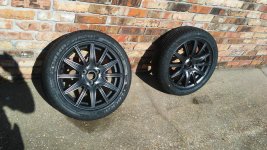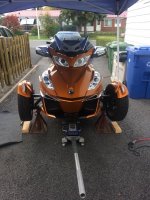I ran 19 psi on my formozas until I blew out one tire hitting a pothole. .......
Jeez, if you blew a higher load rated CAR tire running 19psi in it just hitting a pothole, I can only
imagine the damage it would've caused to you/your Spyder's frame/suspension if you'd had more air in there!! Or if you were running the OE Spec Kendas!! :shocked:
Did it damage the rim at all?? Still, & regardless, I reckon you were
REALLY LUCKY that the tire was able to flex enough to do its job as part of the suspension properly & absorb most of that shock! Admittedly, there is a point of diminishing returns (which for most modern radial car tires, is usually as low as about 8-10 psi) but just like in party balloons, higher pressures generally make tires LESS able to withstand that type of shock-load!! :shocked:
Talking about Party balloons, you can demonstrate this in action for yourself using party balloons - get 2 normal party balloons & blow one up to a reasonable size, but no more than about half way to what you think is its maximum size, and blow the other balloon up as tight & close as you dare to 'full size' without exploding it. Then in turn, press each balloon up against a sharpish edge (not a point - not yet, anyway) and see how the lower pressure balloon flexes & conforms over & around the edge, while the tighter balloon just doesn't - and if you try to press it harder against the edge so that it gets the same degree of flex & conformation as the lower pressure balloon, there'll very likely be an explosion, just like your tire on that pot-hole!! If you don't
quite go that far, so you've still got 2 balloons, get yourself an array of progressively 'pointier' objects, and gently poke each balloon with them in turn, using the same pressure and working up from the most blunt to the pointiest & sharpest; poke the lower pressure balloon first, then the higher pressure balloon, and move from the blunter objects thru to the pointier/sharper objects. You'll find that the lower pressure balloon will withstand being poked by a more pointy object than the higher pressure balloon, because there's not enough flex in the tighter balloon to flex & conform over the point without causing the balloon to explode! :shocked:
If you've got another pair of balloons (after exploding the first pair trying the previous stuff) you can do the same low pressure/high pressure thing to demonstrate how lower pressure tires have more traction than high pressure tires (& resist hydroplaning better, too!) simply by pressing each balloon in turn against the wall, or the carpet (or a wet bench top) with the same degree of force, and then gently trying to slide it along the surface a bit. The lower pressure balloon will 'grip' each surface better, often either forcing you to let it roll it along the surface or not allowing you to move it at all because it grips the surface so well; while the higher pressure balloon will either skip over the surface in a juddering 'slip, grip, slip, grip' sorta way, with demonstrably less 'grip' on the surface for a given moving force, or it'll simply explode! Doing the same 'press onto a surface then gently try to slide it along' thing with the 2 balloons on a smooth wet surface should highlight how the lower pressure balloon still grips the wet surface while the higher pressure balloon simply slides along....
However, please be aware that, like I said earlier, there IS a point of diminishing returns. You CAN go too low with your tire pressures and create a whole 'nuther set of issues, like excessive heat generation & tire delamination amongst other things, but as Blueknight & I have noted a number of times, for a Spyder & the loads you'll be able to reasonably place upon it, with 'normal' car tires (as opposed to the OE Spec Kendas) that 'too low' pressure is pretty low, down around 8-10 psi. There is a whole lot of math & calculations to support this (that I won't bore you any more with) that goes into it, but the end result is that the 'sweet spot' for those 'normal' car tires up front on your Spyder is going to be somewhere between about 14 & 18 psi - for a 'normal' car tire on the rear, it's going to be somewhere between about 16 & 22 psi. Running anything either side of those 'sweet spots' in pretty much anything but an OE Spec Kenda (that really NEED those higher pressures due to their weaker construction) will almost certainly be something of a compromise in terms of the optimal balance between ride, handling, traction, tread wear, fuel economy, & a bunch of other things, but if you choose to go there in your car tires on your Spyder, that's fine by me, just so long as you are
aware that you are making something of a safety compromise! Hey, I've done 'fuel economy runs' with over 65 psi in tires labelled Maximum pressure 30psi, but I drove KNOWING that the tires' rolling diameter was maximised (more distance covered per tire revolution) and their rolling resistance was minimised (easier to drive & roll along) & the steering FELT really direct & responsive, but the tires actually skipped & slid a helluva lot easier so steering was compromised & at the same time the ride was excessively harsh; plus because the tires actually bounced over minor imperfections in the road surfaces their traction was severely reduced, so the vehicles' cornering and braking was also
massively compromised.... and I could go on, but won't for the sake of those who've persisted this far!

pps:
With all that said, while it might've
seemed long, here endeth your
really, Really, REALLY short course in party balloon handling & tire pressures for 'normal' car tires on your Spyders! :thumbup:


